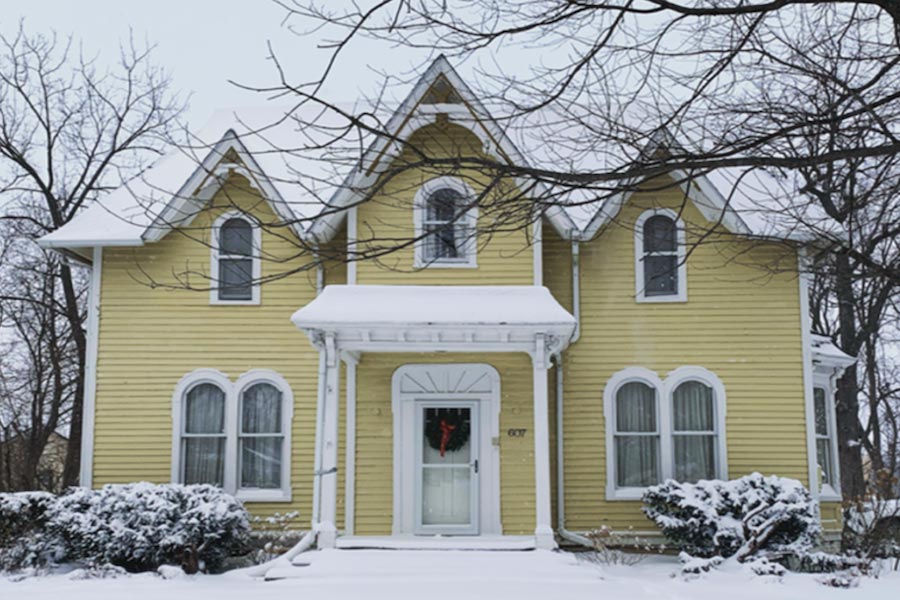Mar 28, 2024
Figuring Out Deep Retrofits in Real Time
A deep energy retrofit with exterior prefabricated panels promises many benefits, and chief among those is that an exterior retrofit minimizes the disruption to the building’s occupants.
By: Mary James

There’s no getting around the fact that decarbonizing the building sector requires accomplishing large numbers of deep energy retrofits, and as of yet, there isn’t a clear pathway toward effectively getting these done at the scale that is needed. A recent research report by the Advanced Building Construction Collaborative estimates that 29.3 million single-family homes and 3.3 million multifamily units are in grave need of deep retrofits—including new windows, air sealing, insulation, ventilation, and swapping out gas appliances for electric ones. Fortunately, some brave souls are undismayed by both the enormity of the task and its inherent difficulties and instead are plunging ahead, devising and iterating solutions.
“We’re exploring these deep energy retrofits through a couple of different lenses and learning a lot in the process,” says Tim McDonald, principal of Onion Flats Architecture (OFA). One of those lenses has been his work with Julie Klump, vice president of design and building performance for the Preservation of Affordable Housing (POAH), which has long been a leader in, well, preserving affordable housing. In 2023, POAH wrapped up a Phius-certified retrofit of Salem Heights, its 281-unit building in Salem, Massachusetts—one of 120 properties POAH owns and manages across 12 states in the Northeast, Midwest, and Mid-Atlantic regions. Despite that project’s challenging aspects—and because of the lessons learned there—Klump hired OFA to make progress on a series of exterior retrofits of similar buildings, starting with the Salem Fairweather.
POAH owns four Fairweather buildings, all of which are in Massachusetts, were designed by the same architect, built by the same company, and are similar in size. And, they were all built at about the same time, which means they are all due up for refurbishing at the same time. “POAH decided to take on the idea of a deep energy retrofit with exterior prefabricated panels on the Salem Fairweather project, in order to use that as a model for the rest of the buildings,” explains McDonald, who has been tasked with translating that idea into action.
This model, once it’s successful, promises many benefits, and chief among those is an exterior retrofit minimizes the disruption to the building’s occupants. “What we’re trying to do here is save the millions of dollars that would be needed to relocate people if we did all of our work from the inside,” McDonald points out.

After a year of planning and extensive conversations with many panel manufacturers, in November 2023 the first mock-up panel was installed on Salem Fairweather. Many lessons were learned on that day. Even more had led up to that day. “We looked at about nine or 10 panel manufacturers, investigated them—got their pricing, availability, and attitude—and it became really clear, really quickly that this is a nascent industry,” McDonald says. There just weren’t a lot of options for a company that was willing to leap into retrofit panel manufacturing at a price that was feasible. Fortunately, OFA found one that fit the bill and is located not far from Salem: Facades X. One of the company’s main advantages was its flexibility and willingness to alter its existing offerings to create an assembly that worked for Salem Fairweather, recognizing perhaps that there’s a large pipeline of potential projects for the company that figures out the right product.
Another lucky stroke for this project was the existing brick wall’s integrity. The OFA team along with the GC for the project, Haycon, had pull-out testing done of the brick at multiple points, and the results showed the wall was still strong enough to handle the added load of these new prefabricated panels. So, instead of having to tie the panels into the structure, they are essentially sitting on shelf angles, which, as McDonald points out, is much, much less expensive.
As with most retrofits, figuring out how to maximize the benefits and the cost-effectiveness of each step is what keeps the project feasible. “I could say the main reason to go with a panelized solution is because we can install the windows in the factory rather than up on a crane one at a time,” explains McDonald, adding, “That relationship between the new window in the panel and the rough opening of the existing window in the wall, that’s kind of where the rubber meets the road. We’ve got to get that right.” To achieve that level of accuracy, a third-party scanning company conducted LIDAR scans of the existing exterior facades and much of the interior of the building as well, converting those scans into a Revit model of the building. Then, OFA and Haycon re-measured many areas on the exterior to verify the dimensions and update the model, which is being used by Facades X to fabricate its panels.
Because the building has six stories, the entire assembly has to meet a two-hour fire rating, which, to a large extent, determines the panel’s components. The framework is a 2×4 metal stud system with an insulated cementitious panel attached to it. Additional Rockwool insulation will add to the assembly’s R-value, delivering a total additional R-value of 30 to the exterior facade. For airtightness, a fluid-applied air and water vapor barrier will be swabbed onto the existing brick façade, and a secondary air barrier is built into the panel itself. A 4-inch gap between the brick and the new retrofit panel will serve as a chase for ductwork, power lines, and line sets for refrigeration, heating, and cooling.

Unsurprisingly, the existing brick wall is not exactly in a straight line, and that three-dimensional inconsistency is adding to the complexity of this retrofit. “Sometimes it’s in plumb, and sometimes it’s out of plumb. It’s kind of all over the map,” he notes. To help address this, the brackets that affix the panels to the brick were selected in part for their tolerance. The panels will get screwed to each other, and any remaining gaps—expected to be about a quarter to half an inch—will be sealed by stuffing them with Rockwool, and then caulking and taping so that the panelized assembly is air- and watertight.
For the team’s general approach to bringing fresh air into a retrofitted multifamily building, McDonald credits architect Chris Benedict, particularly her work with deep energy retrofits from the exterior in New York City. For this building, the team is, of necessity, modifying her strategy. They are planning to install centralized ERVs on the roof and had originally been thinking of building a parapet around the entire roof to hide the ductwork at the top of the building, as Benedict had done. But, the structural engineer advised that was an infeasible addition to the roof structure, as excess rainwater needs to be able to flow off the building. So, the project team is now planning to have a parapet around roughly half the roof, hiding some of the ductwork and leaving others exposed.
The ventilation supply air ductwork will be run down through the 4-inch gap and into each apartment through the window jams. “That really matters because that’s where we’re breaking through the air barrier of the building,” he notes. The exhaust ducts will be threaded through the existing exhaust shafts. The team thinks those shafts are fairly airtight but is planning to have a camera run down and test them to check.
“It’s a much more iterative process when it comes to working with an existing building,” says McDonald. Still, Salem Fairweather is not a unique building to solve. There are three more that are very similar, and then thousands, even millions, more across the country. It’s a big, wide world of retrofits beckoning. “For the next five or six years, I think I’ll stay in Massachusetts and Pennsylvania and try to just get some buildings actually done,” he jokes.
Team
- Architect of Record: Onion Flats Architecture
- General Contractor (GC): Haycon
- Panel Manufacturer: Facades X + Metalleve
- Facade Consultant: Building Energy Corporation (BEC)
- HVAC Engineer: Seaman Engineering Corporation
- Structural Engineer: TLH Consulting
- Electrical Engineer: John Murphy Electrical
- Code Consultant: JS Consulting





